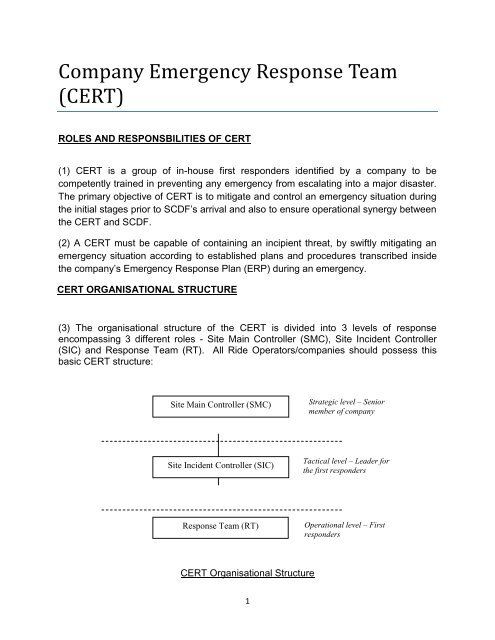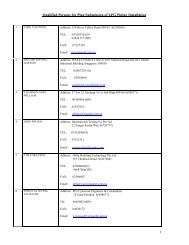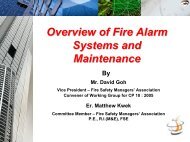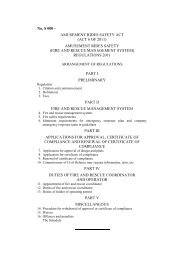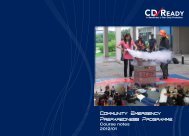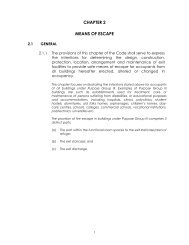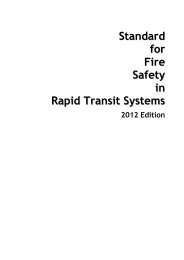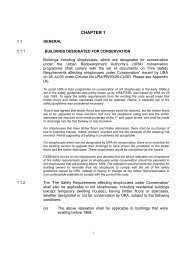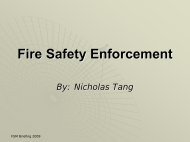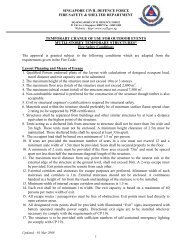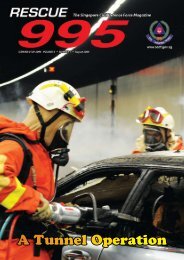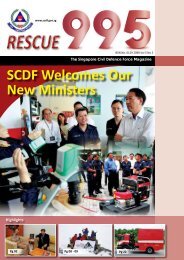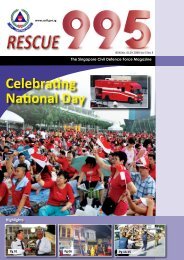Company Emergency Response Team (CERT)
Company Emergency Response Team (CERT)
Company Emergency Response Team (CERT)
Create successful ePaper yourself
Turn your PDF publications into a flip-book with our unique Google optimized e-Paper software.
<strong>Company</strong> <strong>Emergency</strong> <strong>Response</strong> <strong>Team</strong><br />
(<strong>CERT</strong>)<br />
ROLES AND RESPONSBILITIES OF <strong>CERT</strong><br />
(1) <strong>CERT</strong> is a group of in-house first responders identified by a company to be<br />
competently trained in preventing any emergency from escalating into a major disaster.<br />
The primary objective of <strong>CERT</strong> is to mitigate and control an emergency situation during<br />
the initial stages prior to SCDF’s arrival and also to ensure operational synergy between<br />
the <strong>CERT</strong> and SCDF.<br />
(2) A <strong>CERT</strong> must be capable of containing an incipient threat, by swiftly mitigating an<br />
emergency situation according to established plans and procedures transcribed inside<br />
the company’s <strong>Emergency</strong> <strong>Response</strong> Plan (ERP) during an emergency.<br />
<strong>CERT</strong> ORGANISATIONAL STRUCTURE<br />
(3) The organisational structure of the <strong>CERT</strong> is divided into 3 levels of response<br />
encompassing 3 different roles - Site Main Controller (SMC), Site Incident Controller<br />
(SIC) and <strong>Response</strong> <strong>Team</strong> (RT). All Ride Operators/companies should possess this<br />
basic <strong>CERT</strong> structure:<br />
Site Main Controller (SMC)<br />
Site Incident Controller (SIC)<br />
<strong>Response</strong> <strong>Team</strong> (RT)<br />
<strong>CERT</strong> Organisational Structure<br />
1<br />
Strategic level – Senior<br />
member of company<br />
Tactical level – Leader for<br />
the first responders<br />
Operational level – First<br />
responders
(4) The SMC is a senior member of the Ride Operator/company’s management. He is<br />
the overall person-in-charge of emergency response operations in the company and<br />
deals with senior government officials from SCDF, Singapore Police Force (SPF), etc.<br />
The SIC is the leader of the <strong>CERT</strong>, in charge of the incident response. The RT consists<br />
of personnel trained in basic emergency response actions such as fire fighting, rescue<br />
mitigation and other supporting activities such as security, evacuation, first aid etc.<br />
<strong>CERT</strong><br />
COMPONENTS<br />
Site Main<br />
Controller (SMC)<br />
Site Incident<br />
Controller (SIC)<br />
<strong>Response</strong> <strong>Team</strong><br />
(RT)<br />
MANPOWER REQUIREMENTS<br />
ROLES AND RESPONSIBILITIES<br />
Assumes the overall authority and responsibility in<br />
managing the emergency situation and liaising<br />
with officers from government agencies such as<br />
SCDF, SPF, NEA, etc. He/She will be the<br />
representative to link up with the Incident Manager<br />
(SCDF) to assist in the incident management.<br />
Assumes command and control of the emergency<br />
response incident scene and co-ordinates the<br />
activities of all emergency responders, providing<br />
support to SCDF for mitigation of the emergency<br />
situation.<br />
Conducts basic emergency response actions such<br />
as fire fighting, rescue and HazMat mitigation<br />
under the command of the SIC.<br />
Assists in emergency notification and public<br />
protective actions, accounting for personnel<br />
outside the hazard zone or implementing In-Place<br />
Protection (IPP) within the workplace.<br />
(5) All Ride Operators/companies that require <strong>CERT</strong> should maintain a minimum <strong>CERT</strong><br />
configuration of at least 6 members (comprising 1 SMC, 1 SIC and 4 RT members) or<br />
more to sufficiently handle the worst credible scenario effectively. The final <strong>CERT</strong><br />
configuration set up by the company shall be subjected to SCDF’s approval through the<br />
<strong>CERT</strong> audit.<br />
(6) The <strong>CERT</strong> could comprise security guards, safety staff, technical staff, operations<br />
staff as well as any other employees within the premise. The team should be familiar<br />
with the Ride’s ERP. They should be adequately trained to provide initial response to<br />
the scenarios described in the ERP.<br />
2
TRAINING REQUIREMENTS<br />
(7) Training has an important bearing on the safety and proficiency of the <strong>CERT</strong> and can<br />
make a significant difference in the <strong>CERT</strong>’s response during the initial stages of an<br />
incident. The Ride Operator should provide adequate emergency response training to<br />
all their staff. SIC and first responders should be trained in fire-fighting and rescue<br />
operation.<br />
(8) The training provided may be customised to suit the Ride Operator’s operating<br />
environment. A general guideline on the training requirements to meet the various roles<br />
are as below.<br />
Training<br />
Requirements<br />
Fire Fighting &<br />
Rescue<br />
<strong>Response</strong><br />
Incident<br />
Management<br />
Types of Training <strong>CERT</strong> Members<br />
Fire protection systems in<br />
buildings/process plants<br />
Use of breathing apparatus<br />
First attack fire fighting using various<br />
extinguishing media (e.g.<br />
extinguishers, hose reels, hoses and<br />
nozzles)<br />
First aid and CPR<br />
Evacuation<br />
Safety precautions<br />
Appreciation of situation<br />
Strategic and tactical operations<br />
Roles and responsibilities<br />
<strong>Response</strong> planning<br />
Contingency planning<br />
<strong>Emergency</strong> scene management<br />
Overview of SCDF incident<br />
management system<br />
<strong>Emergency</strong> information management<br />
Table-top planning exercises<br />
(9) To ensure that the <strong>CERT</strong> remains relevant and current, each Ride Operator is<br />
recommended to conduct in-house refresher courses. Alternatively, the Ride Operators<br />
can engage external trainers to conduct in-house training or send their <strong>CERT</strong> to training<br />
institutions for refresher courses.<br />
3<br />
<strong>Response</strong> <strong>Team</strong><br />
Site Incident<br />
Controller<br />
Site Main<br />
Controller<br />
Site Incident<br />
Controller
EQUIPMENT READINESS AND MAINTENANCE<br />
(10) The equipment used by the <strong>CERT</strong> should be able to handle the initiating event of<br />
the worst credible scenario described in the ERP and the types of hazards present<br />
within the premises. Although a Ride Operator can consider requesting for assistance<br />
in the form of mutual aid agreement with their neighbouring premises, it is still required<br />
to maintain sufficient equipment to handle the initial phases of an emergency.<br />
Equipment should be regularly maintained and stored in accessible locations. Some<br />
equipment required is:<br />
a. Personal Protective Equipment (PPE)<br />
The Ride Operators should equip their <strong>CERT</strong> members with the<br />
appropriate PPE. All PPE should be kept in accessible locations for easy<br />
retrieval during an emergency. Regular maintenance of the equipment is<br />
important to ensure that it is in good working condition at all times. <strong>CERT</strong><br />
should be sufficiently trained to don their PPE competently.<br />
b. <strong>Emergency</strong> <strong>Response</strong> Equipment<br />
<strong>Emergency</strong> response equipment refers to detection and mitigation<br />
equipment. The equipment should be properly maintained to ensure<br />
optimal performance during emergencies. <strong>CERT</strong> should be regularly<br />
trained to be proficient in the usage of the equipment.<br />
c. Communication Equipment<br />
To ensure proper communication, the company should provide <strong>CERT</strong><br />
members with radio communication sets and/or loudhailer or any other<br />
equivalent form of communication tools.<br />
EMERGENCY PLANS AND STAFF AIDS<br />
<strong>Emergency</strong> Plans<br />
(11) It is crucial for the Ride Operators to identify and quantify hazards and risks related<br />
to the rides. This is through developing an ERP to detail the various preventive<br />
measures and operational actions that need to be undertaken by the company to<br />
mitigate the worst credible scenario.<br />
(12) The Ride Operators should place great emphasis on preparing the written<br />
emergency plans, keeping them up-to-date and ensuring that they have been briefed to<br />
all employees. They should be placed in an accessible location for workers to view and<br />
retrieve during an emergency.<br />
4
Staff Aids<br />
(13) Besides the Ride’s ERP, other important supporting documents such as maps and<br />
diagrams and technical specifications of the rides will assist the SCDF Ground<br />
Commander to better appreciate the surrounding hazards. These documents, also<br />
known as emergency staff aids, should be regularly updated and available at all times:<br />
a. Site/ Plant layout diagrams;<br />
b. Layout plans and inventory list of hazardous substances if any;<br />
c. <strong>CERT</strong> activation flowchart;<br />
d. <strong>Emergency</strong> contact list;<br />
e. Materials Safety Data Sheets (MSDS);<br />
f. <strong>Emergency</strong> control points (e.g. <strong>CERT</strong> assembly point, evacuee assembly<br />
point, first aid point);<br />
g. Government agencies contact numbers (e.g. SCDF, SPF); and<br />
h. Recovery contractor contact number.<br />
Certification Requirement<br />
(1) In order to ascertain the competency level of the <strong>CERT</strong> in carrying out its tasks in an<br />
emergency, SCDF shall conduct audits through documental checks and practical<br />
assessments on the companies. The onsite audits of the <strong>CERT</strong>s will serve as an<br />
opportunity to identify strengths and weaknesses of their capability. During the audits,<br />
the <strong>CERT</strong>s have to successfully demonstrate their response capability through a list of<br />
specific activities such as incident size-up and fire fighting operations. Each of the<br />
activities consists of individual and specific tasks that have to be carried out as<br />
stipulated in the <strong>CERT</strong> Audit Checklist.<br />
<strong>CERT</strong> AUDIT WORK PROCESS<br />
Scheduling of Companies for <strong>CERT</strong> Audits<br />
(2) Ride Operators applying for the ARSA licence will need to submit their ERP to SCDF<br />
for verification and scheduled for mandatory <strong>CERT</strong> audits.<br />
5
(3) Notification letters will be sent to the Ride Operators to inform them of the date and<br />
time of their audits 1 month in advance of the audit dates that will be mutually agreed by<br />
the Ride Operators.<br />
Confirmation of Audit Scenario<br />
(4) The audit team will visit the company one week before the scheduled practical audit<br />
date to go through the documents for the documentation aspect of the audit and to<br />
discuss with the company’s SMC or SIC, the scenario to be exercised during the<br />
practical audit. The scenario should be based on the worst credible scenario depicted<br />
in the company’s ERP.<br />
Conduct of <strong>CERT</strong> Audit<br />
(5) The audit team will conduct the <strong>CERT</strong> practical audit on the scheduled date. The<br />
<strong>CERT</strong> audit will be conducted in 2 phases: the interview phase; and exercise phase:<br />
a. Interviews are first conducted for the <strong>CERT</strong> members to test the<br />
understanding on their functions. These include the followings:<br />
i) Their understanding of their individual role and functions;<br />
ii) Their expected actions in the exercised scenario;<br />
iii) The activation phase of the scenario is evaluated by interviewing<br />
any company personnel on their knowledge of raising the alarm<br />
during an emergency; and<br />
iv) The <strong>CERT</strong> is also checked if they meet the minimum manpower<br />
requirement and organization structure.<br />
b. For scenario exercise, the <strong>CERT</strong> will be evaluated on the following activities:<br />
i) Activation and response of <strong>CERT</strong>;<br />
ii) Incident size-up;<br />
iii) Fire fighting and mitigation operations;<br />
iv) Support activities such as evacuation, medical treatment and<br />
security;<br />
v) Linking up with SCDF upon arrival; and<br />
vi) Ongoing operations and recovery.<br />
6
(6) At the end of the onsite assessment, the Audit <strong>Team</strong> will conduct a debrief session<br />
with the Ride Operators (includes at least the SMC or SIC) on the result and<br />
performance of the onsite <strong>CERT</strong> assessment. Any areas of improvement and<br />
recommendations will be highlighted to help the <strong>CERT</strong> improve their future responses.<br />
Follow Up Actions<br />
(7) Within 2 weeks from the successful completion of the <strong>CERT</strong> audit, the Audit team<br />
shall send the post-audit reports, highlighting on the strengths, weaknesses and<br />
recommendations for the <strong>CERT</strong>.<br />
Enforcement Actions<br />
(8) For all Ride Operators, new 1 or repeated 2 Ride Operators, which fail the audit,<br />
SCDF will issue a written direction to the company for the Ride Operators to improve on<br />
its <strong>CERT</strong> response. Another date will be scheduled by SCDF for the conduct of re-audit<br />
within 2 weeks. The scenario of the re-audit will be based on the same scenario as the<br />
first audit. The company shall be notified of the date of the re-audit via the notification<br />
letter.<br />
(9) The Ride Operators must pass the Audit Certification Test before they can be<br />
allowed to operate the Amusement Rides.<br />
COMPETENCY IN PRACTICAL ASSESSMENT<br />
(10) Practical assessment exercises, conducted collaboratively by SCDF and the Ride<br />
Operators, are key instruments for assessing and improving performance. A fire or<br />
rescue scenario is proposed by SCDF based on the worst credible scenario laid out in<br />
the company’s ERP. The desired outcome of the exercise is to certify that the<br />
company’s <strong>CERT</strong> is capable of containing an incipient threat, by swiftly mitigating an<br />
emergency situation according to established plans and procedures. During a practical<br />
exercise, the <strong>CERT</strong> should successfully demonstrate these capabilities through specific<br />
activities which include:<br />
a. Activation and <strong>Response</strong> of <strong>CERT</strong>;<br />
b. Incident Size-Up;<br />
c. Fire Fighting/Rescue and Mitigating operations;<br />
d. Support Activities;<br />
1 A new Ride Operator refers to a Ride Operator which is going through the audit for the first time<br />
2 A repeated Ride Operator refers to a Ride Operator which has gone through the <strong>CERT</strong> audit before<br />
7
e. Linking up with SCDF upon arrival; and<br />
f. Ongoing operations and recovery.<br />
(11) Every <strong>CERT</strong> should follow the guidelines as a demonstration of their capability to<br />
handle an emergency situation.<br />
a. Activation and <strong>Response</strong> of <strong>CERT</strong><br />
The first person who discovers the fire incident should activate the nearest fire<br />
alarm call point, confirm the location of the incident with the Fire Command Centre<br />
(FCC) by any means of communication equipment (e.g. walkie talkie or phone)<br />
and attempt to put out the fire situation i.e. by shutting valve or activating<br />
drenching systems if the situation permits.<br />
The first person who discovers the rescue incident should confirm the location of<br />
the incident with the Fire Command Centre (FCC) by any means of communication<br />
equipment (e.g. walkie talkie or phone).<br />
The FCC should carry out the following actions after being notified of the incident:<br />
i. Call SCDF hotline and alarm monitoring agencies;<br />
ii. Alert the company staff on the nature and location of the<br />
emergency by means of siren, loud hailer or Public Announcement<br />
(PA) system;<br />
iii. Activate <strong>CERT</strong> to respond to the incident site; and<br />
iv. Notify the neighbouring companies of the emergency.<br />
The <strong>CERT</strong> members, upon activation, should gather at the <strong>CERT</strong> Assembly Point<br />
with the necessary response equipment within 1 minute and reach the incident site<br />
within 5 minutes.<br />
b. Incident Size-Up<br />
The SIC should respond straight to the incident site upon activation and perform<br />
the following activities:<br />
i. Verify the incident;<br />
ii. Conduct site assessment; and<br />
iii. Determine the extent of the emergency.<br />
8
SIC should provide a verbal situation report to the FCC and instruct the <strong>CERT</strong><br />
members.<br />
c. Fire Fighting/Rescue and Mitigation Operations<br />
The RT consists of personnel trained in basic emergency response actions such<br />
as fire fighting and rescue mitigation. First responders should don the<br />
appropriate PPE, mitigate the fire and rescue any casualties within their means.<br />
Depending on scenario requirements, the RT should attempt to extinguish the<br />
fire as much as possible.<br />
In the midst of fire fighting/rescue and mitigation operations, the SIC should<br />
assume the role of an Incident Commander. After determining the control zones<br />
for the incident site, the SIC should set up a field incident command post in the<br />
safe zone and await the arrival of SCDF’s Ground Commander. From this<br />
position, the SIC should command and direct the RT, oversee their safety and<br />
maintain constant communication with them.<br />
d. Support Activities<br />
The RT can also include first aid personnel, operators and security wardens to<br />
perform other supporting activities. First aid personnel would need to perform<br />
basic first aid and CPR on evacuated casualties, manage a list of casualties and<br />
maintain communication with the SIC. Security wardens should secure the<br />
company’s premises and facilitate rapid movement of SCDF responders upon<br />
their arrival. The <strong>CERT</strong> as a whole should also ensure the smooth and orderly<br />
evacuation of all company employees by guiding them to the Evacuees<br />
Assembly Area (EAA), perform a thorough search of the premises to ensure that<br />
no personnel are left behind, and perform a head count at the EAA to account for<br />
all company personnel. For rescue operations, the <strong>CERT</strong> should execute the<br />
appropriate rescue equipment or apparatus to evacuate trapped occupants such<br />
as the use of cherry pickers to bring down trapped occupants from height<br />
reachable by the vehicle.<br />
e. Linking Up with SCDF Upon Arrival<br />
The <strong>CERT</strong> should provide the initial response to an emergency in order to<br />
prevent initiating events from escalating into a major incident. Upon the arrival of<br />
SCDF, the SMC and SIC should conduct proper handing over of incident<br />
command and provide the following to the SCDF Ground Commander:<br />
i. Site Layout Map;<br />
ii. Building plan;<br />
9
iii. <strong>Company</strong> emergency response plan;<br />
iv. <strong>Company</strong>’s HazMat inventory and location of HazMat inventory (for<br />
petroleum and flammable fires);<br />
v. Overall workers’ population;<br />
vi. <strong>Emergency</strong> equipment and resources available on site;<br />
vii. General description of the incident including possible risks and hazards;<br />
viii. <strong>CERT</strong> resources deployed;<br />
ix. Casualty numbers and personnel unaccounted for;<br />
x. Resources available to assist SCDF operations; and<br />
xi. Suggest mitigation means.<br />
f. Ongoing Operations and Recovery<br />
After briefing the SCDF Ground Commander, the <strong>CERT</strong> should continue to<br />
support SCDF in its fire fighting & rescue mitigation efforts until the end of the<br />
operation. Once the exercise has formally concluded, the SIC is expected to<br />
perform recovery and wind-down operations by:<br />
i. Ensuring that all personnel and equipment are properly accounted for;<br />
ii. Ensuring the rides obtain the necessary clearances from the relevant<br />
authorities before they resume operations; and<br />
iii. Assisting SCDF or the relevant authorities in the investigation of the<br />
incident.<br />
Crisis Management <strong>Team</strong> (CMT)<br />
The Ride Operators shall also involve their senior management in the overall crisis<br />
management framework of the rides. The Rides’ management personnel shall be<br />
tasked to manage the wide spectrum of issues that can arise due to any incident or<br />
accident including the management of the next-of-kins, media, compensation etc. The<br />
roles, functions and taskings of the CMT must be clearly spelled out.<br />
Annual Tabletop and Ground Deployment Exercises<br />
The Ride Operator must conduct an annual tabletop and ground deployment exercise<br />
with SCDF to ensure the ERP is current and relevant.<br />
10
Special Operational Requirements to Facilitate SCDF’s Rescue Operations<br />
The Ride Operator must be equipped with the means to mitigate the risk of the rides<br />
that they operate. They may be required to provide commercial height equipment or<br />
apparatus (cranes, cherry pickers etc) for rides where occupants may be stuck in midair.<br />
The Ride Operator is also required to provide rescue facilities or gadgets (examples are<br />
ropes, anchoring points, carabineers and harnesses) as deem necessary by SCDF for<br />
rescue operations.<br />
11


